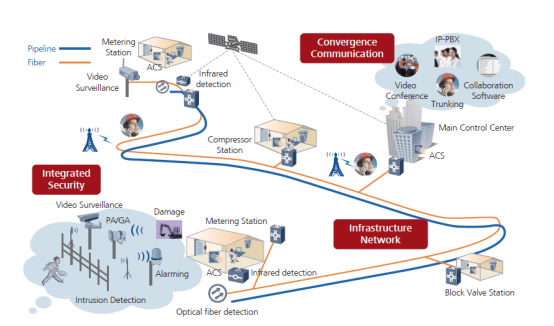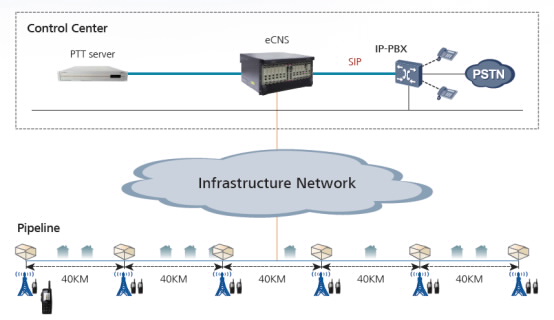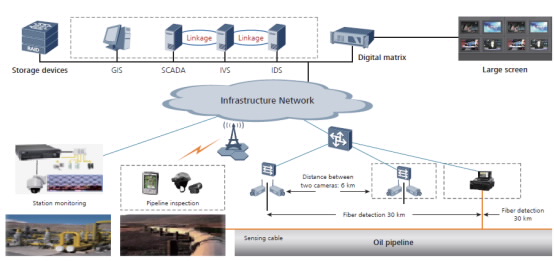Approximately 85% of all oil and gas is carried through pipelines, making them the most important method of transportation. Therefore, maintaining secure and stable pipeline transportation, coupled with effective communication, is crucial. Huawei has carefully studied the communications and security issues the industry faces and identified the following challenges.
- Manual inspections of pipelines are labor-intensive, time-consuming, and often incomplete as teams are usually only able to cover key sites and main lines because of the distances and terrain involved
- Existing standalone office systems (including scheduling, conferencing, and telephone systems) are fragmented and not interoperable, and incur high operation and maintenance costs
- The harsh environments pipelines operate in subject them to frequent corrosion and natural disasters. Because the pipelines cover such large areas damages from these occurrences are often not discovered until after the fact, resulting in higher repair costs.
- Man-made incidents, such as nearby construction that damages the pipeline or intentional mutilation because of theft, pose constant hazards to pipelines and patrols
The Huawei Digital Communications Solution for Pipelines consists of three layers: infrastructure networks, united communications, and integrated security. This multi-layered approach addresses the challenges of distance, operation and maintenance, costly manual oversight, and harsh environments.
Huawei’s multi-layered network solution provides oil and gas companies with guaranteed reliable communications across large distances. This solution also integrates varied and sometimes non-interactive office systems into a single communications platform that incorporates an intelligent security surveillance system.
Digital Communications Solution for Pipelines Diagram

Infrastructure Networks
Critical pipeline infrastructure stays connected no matter the distance and topography with the Huawei infrastructure solution. Control centers, metering stations (MS), compressor stations (CS), and valve stations (BVS) are linked by an optical transmission network. For stations in remote areas or in locations where it is difficult to route optical cables a microwave transmission system can be constructed.
In the event that optical transmissions are interrupted, important services like supervisory control and data acquisition (SCADA) and hotline services are switched over to the Very Small Aperture Terminal (VSAT) system. By automatically backing up the entire network the VSAT system maintains a link between key sites such as the control center, metering stations, and compressor stations to ensure continuous operation.
Infrastructure Network Overview

Unified Communications
Eliminate outdated and costly stand-alone office systems with the unified communications solution from Huawei. Combining all communications; including voice, video, and data into one central source eliminates redundancies and saves money.
The Huawei solution connects Private Branch eXchange (PBX) voice systems to the Public Switched Telephone Network (PSTN) to ensure connectivity with the fixed network or carrier network. The PBX voice system is also connected to the LTE-based enterprise Core Network System (eCNS) via the Session Initiation Protocol (SIP). This infrastructure layout permits multiple services to be carried on one line, thus enabling streamlined communication between videoconferencing, telephone, trunking, and scheduling services.
Pipeline security and maintenance is managed via base-station equipment, using a digital cluster system, deployed at 40 Km intervals alongside pipelines to provide full coverage. The waterproof, dustproof, and blast-resistant cluster devices also facilitate wireless cluster scheduling and collaboration on pipeline patrol, maintenance, and emergency response.
Unified Communications Diagram

Integrated Security System
The integrated security system combines the ability to monitor physical security and detect leaks in pipelines and at stations. The comprehensive security system consists of an Intelligent Video Surveillance (IVS) system, SCADA system, Intrusion Detection System (IDS) and access control system linked to security and monitoring systems. The IVS includes alarm links with the SCADA and IDS and works with the GIS to maintain a surveillance umbrella over sites.
The surveillance images, collected by devices like IP cameras located alongside pipelines, are saved on a local disk array or sent to a disk array at the control center. Using application and management systems, the images can be browsed, replayed, and managed for emergency response and problem tracking.
Integrated Security System Diagram

Using real-time data and video feeds, Oil and Gas companies can now monitor the security and health of their entire pipelines, no matter how remote. By automating metering, flow, pressure, and other critical signals companies can decrease the necessary personnel by up to 50%. Plus, having an automated data collection system (aka SCADA) enables oil and gas companies to immediately mitigate risks and improve productivity via comprehensive information about the entire pipeline.
- Stop leaks before they occur, using real-time pipeline monitoring systems that spot corrosion or damage
- Analyze current and historic data to forecast potential issues using the integrated SCADA system
- Bring together teams separated by distance and borders via unified communications tools that both improve efficiency and speed emergency responsiveness
- Identify threats, such as illegal intrusions, damage caused by construction or accidents, and theft in real time, regardless of location along the pipeline
- Minimize costly repairs or potential harm to employees via early warning and emergency response systems
- Maintain uninterrupted transmission of critical data —via a double failsafe system using both fiber optic cables and satellites—so pipelines remain open and functional
Contact a Huawei Partner for Digital Oil and Gas Production Solutions, or Email Us for more information.




